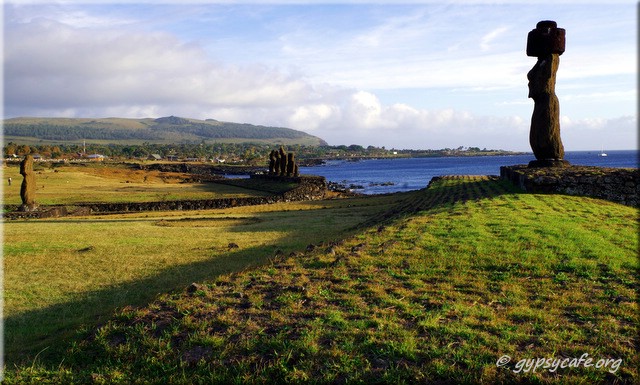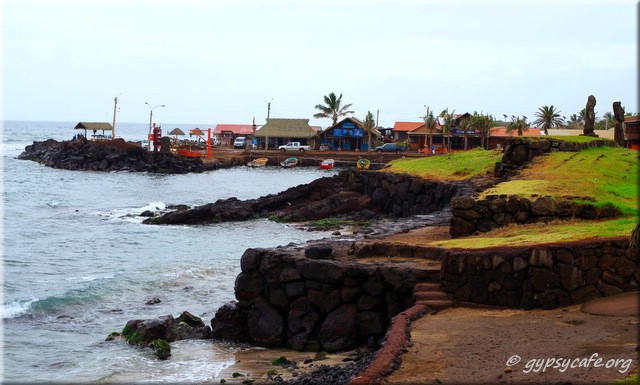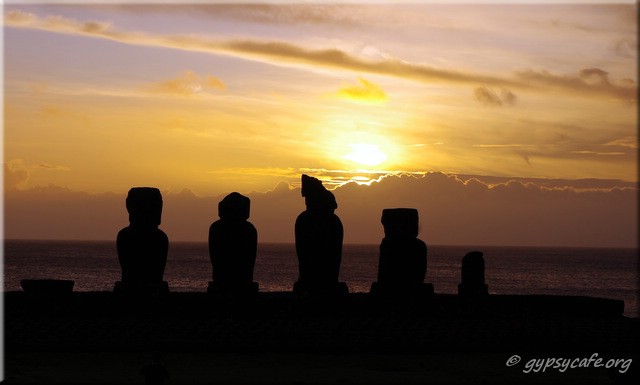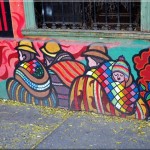Travelogue: Rapa Nui – Days 1 & 2 (June 2015)

Day 1: After about five hours of flight time from Santiago, we were nearing our destination. Serious turbulence started up during our descent in the stormy weather. Just before touch-down a very strong tug to the left occurred, then to the right, followed by a hard bounce as wheels connected with rain-soaked tarmac, complimented with (some) veering and swerving, but no skidding, until the plane came to a standstill. A group of Rapanui behind me broke into rapturous clapping, cheering and conversation. They were home. As we got ready to disembark a young local fellow said loudly to the passenger next to me: “Welcome to my island!” (Stressing the my and the s).
No doubt, Easter Island-bound LAN airline pilots are experts in bad weather landing, especially this time of the year, although the second round of premium whisky so generously distributed in economy class by cabin staff, did take on some extra meaning right then. Or maybe that was just because we were about to visit a premium destination in every organic sense of the word.
I didn’t buy or read a guidebook beforehand; I arrived unprepared, except for bringing all-weather clothing and a water resistant camera. This was to be a bare-bones hiking and photography trip and I was looking for a direct experience. I would hopefully come away with some thoughts or insights about the history of this very intriguing and enigmatic island, but would do in-depth reading or research later on.
In the arrivals lounge I was met by my B&B host who graciously came to collect me and I received a traditional Polynesia welcome with flowers being placed around my neck. At 1 am in the morning as we drove down the main street of Hanga Roa, the only town on Easter Island situated right next to the landing strip, he commented in Spanish on the bad weather and the delayed flight arrival.
Day 2: The next morning there was no leaving the large house as torrential downpours and gusts of wind provided dramatic entertainment outside. I knew beforehand it would not be ideal to visit Rapa Nui during the low season, especially regarding photography, but I had to factor in travel and accommodation costs as this is not a low-cost destination. However, I was positive that the weather would grant me a couple of sunny days. One of the guests at the B&B informed me that according the weather forecast it would rain for at least two or three more days. I soon learned that all weather forecasts related to the island are highly unreliable and when asking locals about the weather, most would usually just shrug their shoulders and calmly say: “We don’t know”.

I managed to leave the hotel for the first time around 4pm and had a brief walk around town. After shopping for essentials I took a spontaneous stroll along the sea front past the harbour and then continued up the coast for a few hundred meters until I came across Tahai, an impressive Moai platform. Here there were a few people strolling around and taking pictures, while others started taking their seats to experience the sunset. I joined them, the weather remained clear and it was almost an hour and a half before the sun finally set behind these ancient silhouetted monoliths, which provided for an extended and silent meditative experience.

While relaxing I decided that due to the unpredictability of the weather, I’m just going to get out there every day, come rain or shine. I wanted to cover as much as possible of Rapu Nui on foot, as far as that would be possible – and in a nutshell the rest of my stay comprised of a daily combination of the following activities: waking up early, hiking, sheltering from the rain, exploring the island undisturbed, following the horse paths, being in remote areas, taking photographs, naturally stumbling across various archaeological sites and points of interest, running out of daylight, hitch-hiking back, cooking for myself in the evenings and sharing information with other guests.
The rest of this travelogue will focus on the highlights encountered during the following few days.
Photographs and text by Jean-Jacques Montagnier
Copyright © 2015 – All Rights Reserved – Gypsycafe.org


4 Comments
I was wondering if you know what the English meaning for the Rapanui word Tahai that you mention in this post is? It might seem kind of dumb but it’s a really nice-sounding word and I’d like to know what it means.
Hello, thanks for visiting. I will have a look in my guide book, which I still have around and will get back to you in a day or two – watch this space…
There’s not much information in my guide book, but I found a Rapanui to English dictionary online and the closest word is Taha – which means “sunset”. I won’t be surprised if this is the root word for the name, because Tahai is famous for its sunsets, although this would probably have to be confirmed by someone who speaks Rapanui or one of the Polynesian languages like Hawaiian.
Here’s the link to the dictionary page:
http://kohaumotu.org/Rongorongo/Dictionary/dictionary_complete.html#t
Pingback: Gobekli Tepe and The City of Prophets | Gypsy Café